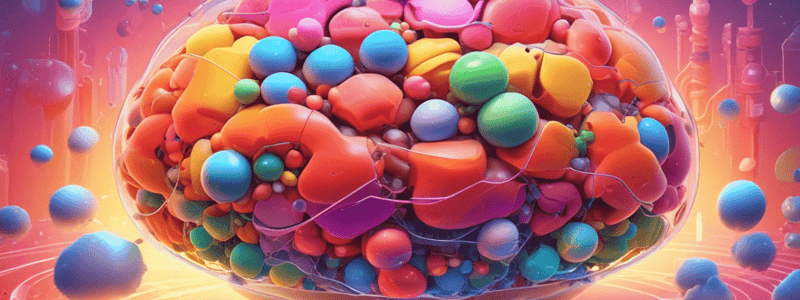Podcast
Questions and Answers
Which of the following is NOT a characteristic of catabolic reactions?
Which of the following is NOT a characteristic of catabolic reactions?
- Breaking down larger molecules to release energy
- Storing excess energy as glycogen or fat
- Producing ATP as the energy currency of the body
- Producing larger molecules from smaller ones (correct)
What is the primary function of the Krebs cycle (also known as the citric acid cycle or tricarboxylic acid cycle)?
What is the primary function of the Krebs cycle (also known as the citric acid cycle or tricarboxylic acid cycle)?
- To oxidize fatty acids for energy
- To convert pyruvate into acetyl CoA
- To produce NADH and FADH2 for the electron transport chain (correct)
- To generate ATP directly through substrate-level phosphorylation
Which of the following is NOT a catabolic hormone?
Which of the following is NOT a catabolic hormone?
- Cortisol
- Epinephrine
- Insulin (correct)
- Glucagon
What is the primary purpose of the electron transport chain (ETC)?
What is the primary purpose of the electron transport chain (ETC)?
What is the main purpose of gluconeogenesis?
What is the main purpose of gluconeogenesis?
What is the primary function of lipolysis?
What is the primary function of lipolysis?
During the absorptive state, which of the following is true?
During the absorptive state, which of the following is true?
Which of the following is NOT a product of the electron transport chain (ETC)?
Which of the following is NOT a product of the electron transport chain (ETC)?
What is the primary function of lipogenesis?
What is the primary function of lipogenesis?
During the postabsorptive state, which of the following is true?
During the postabsorptive state, which of the following is true?
What percentage of the heat generated during ATP production is lost through radiation?
What percentage of the heat generated during ATP production is lost through radiation?
Which of the following components of the body's energy expenditure accounts for the largest portion?
Which of the following components of the body's energy expenditure accounts for the largest portion?
According to the information provided, what is the approximate caloric equivalent of one pound of fat?
According to the information provided, what is the approximate caloric equivalent of one pound of fat?
Which of the following statements about vitamins is true?
Which of the following statements about vitamins is true?
Which of the following processes is responsible for the least amount of heat loss in the human body?
Which of the following processes is responsible for the least amount of heat loss in the human body?
What is the term used to describe the energy expended by the body at rest, in a neutral environment, and in a postabsorptive state?
What is the term used to describe the energy expended by the body at rest, in a neutral environment, and in a postabsorptive state?
What is the primary function of lymph nodes?
What is the primary function of lymph nodes?
Which of the following statements accurately describes the structure of lymphatic capillaries?
Which of the following statements accurately describes the structure of lymphatic capillaries?
Which of the following areas of the body does NOT have lymphatic vessels?
Which of the following areas of the body does NOT have lymphatic vessels?
What is the primary function of natural killer (NK) cells?
What is the primary function of natural killer (NK) cells?
Which of the following statements accurately describes the thymus gland?
Which of the following statements accurately describes the thymus gland?
Which of the following is NOT considered a barrier defense against pathogens?
Which of the following is NOT considered a barrier defense against pathogens?
Which type of hypersensitivity reaction involves IgE binding to mast cells causing degranulation and rapid reactions?
Which type of hypersensitivity reaction involves IgE binding to mast cells causing degranulation and rapid reactions?
What is the immediate cause of death for individuals infected with HIV/AIDS?
What is the immediate cause of death for individuals infected with HIV/AIDS?
In which type of hypersensitivity reaction does systemic disease cause antigens and antibodies to accumulate along blood vessel linings?
In which type of hypersensitivity reaction does systemic disease cause antigens and antibodies to accumulate along blood vessel linings?
What treatment is typically used for rapid and severe hypersensitivity reactions involving mast cell degranulation?
What treatment is typically used for rapid and severe hypersensitivity reactions involving mast cell degranulation?
What type of immune response is involved in Type 4 hypersensitivities that results in delayed symptoms?
What type of immune response is involved in Type 4 hypersensitivities that results in delayed symptoms?
What is the primary strategy for treating autoimmune diseases when tolerance breaks down?
What is the primary strategy for treating autoimmune diseases when tolerance breaks down?
What is the primary function of the lymph nodes?
What is the primary function of the lymph nodes?
What is the purpose of the lymphoid nodules found in the respiratory and digestive tracts?
What is the purpose of the lymphoid nodules found in the respiratory and digestive tracts?
What is the purpose of the mucosa-associated lymphoid tissue (MALT) found in various parts of the body?
What is the purpose of the mucosa-associated lymphoid tissue (MALT) found in various parts of the body?
What is the primary function of the afferent and efferent lymphatic vessels in relation to the lymph nodes?
What is the primary function of the afferent and efferent lymphatic vessels in relation to the lymph nodes?
What is the primary function of bronchus-associated lymphoid tissue (BALT)?
What is the primary function of bronchus-associated lymphoid tissue (BALT)?
Which of the following statements about the innate immune response is true?
Which of the following statements about the innate immune response is true?
What is the primary function of perforins?
What is the primary function of perforins?
What is the role of pattern recognition receptors in the innate immune system?
What is the role of pattern recognition receptors in the innate immune system?
What is the primary function of chemokines?
What is the primary function of chemokines?
Which of the following statements about the inflammatory response is true?
Which of the following statements about the inflammatory response is true?
What is the primary difference between acute and chronic inflammation?
What is the primary difference between acute and chronic inflammation?
What is the primary difference between the primary and secondary adaptive immune responses?
What is the primary difference between the primary and secondary adaptive immune responses?
What is the primary function of cytotoxic T cells?
What is the primary function of cytotoxic T cells?
What is the primary function of regulatory T cells?
What is the primary function of regulatory T cells?
Flashcards are hidden until you start studying



